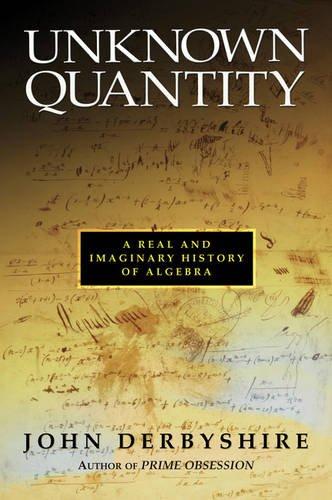Category Archives: `
Summer Books: The Future
ID: The Quest for Identity in the 21st Century by Susan Greenfield
The Baby in the Mirror by Charles Fernyhough
The Suspicions of Mr Whicher or the Murder at Road Hill House by Kate Summerscale
Physics of the Impossible by Michio Kaku
Shuffling symmetries

How many symmetries can you find in the letter that begins this sentence? You will probably count the symmetries to do with reflection – swapping the “H” left-to-right, up-to-down and across diagonals – before you think to add a rotational symmetry to the list, turning the letter through 180 degrees. If you could pick the letter up, you could also flip it over: another rotational symmetry. If you turned it around and then flipped it over, would this be the same as flipping it over and turning it around?
How would you find out? The whole point about symmetry is that it allows an object to change its orientation without altering its appearance. This can be a headache even when handling two-dimensional objects. Ever tried feeding letterhead paper into an unfamiliar printer? Now imagine handling a 196,883-dimensional object.
Reading takes time, and time destroys symmetry. Nonetheless, Du Sautoy has invested a lot in creating a very symmetrical book, one whose ends are thinner than its middle. We begin and end gently. Symmetry appears in the real world, metastasizes through multidimensional space, then returns to earth for a long, gentle decompression.
To start with, we are told that symmetry has prestige. It’s expensive to do: only the fittest and healthiest plants and animals can afford to devote resources to it. So symmetry carries meaning: it is a sign of success. Symmetry has cultural prestige for the same reason: without access to mass-manufacture, symmetrical objects are hard to craft. Near the end of Du Sautoy’s account we hear symmetry in music, discover a connection between symmetry and empathy, and we see why, although symmetrical shapes are hard for living things of any size to achieve, they are easy for things that are very small. Some viruses are Platonic solids – objects that are symmetrical in three dimensions. Death, more often than not, has 20 faces: herpes, rubella and HIV are all icosahedrons.
The real work of the book is its middle. Some objects are more symmetrical than others, and this is as true of hypothetical, impossible-to-visualise multidimensional objects as it is of dice and bathroom tiles. How do we find symmetrical objects we can’t see – and how do we work out how their symmetries relate? In the middle of the 20th century, a branch of mathematics called group theory devoted 30 years to an exhaustive hunt for new species of multidimen-sional symmetry. This hunt shared some qualities with astronomy. Just when you think your account of the cosmos is complete, someone working on another continent rings up to report something inexplicable.
To bring us up to speed with group theory, Du Sautoy rattles through a lot of history. There is not a lot else he can do. The best way of explaining maths is through the history of maths. The history is not really the point – and this is as well, since he unapologetically describes in geometrical terms much work that acquired its relevance for symmetry only much later. Du Sautoy’s strategy places clarity a long way above precision. His hope is that the reader can visualise, more than understand. “A child starting out on an instrument will have no idea… how to improvise a blues lick, yet they can still get a kick out of hearing someone else do it.” Finding Moonshine is a superlative mathematical entertainment; not pretty to the purist eye, but oh, so effective.
Du Sautoy adds whig memoir to whig history when he harnesses himself and his family to his account. He neatly captures his spiky relations with his son Tomer; at one point he tells him off for using his Nintendo, only to discover the poor kid was using it to study the very symmetries his father lives for. Attempts to personalise a subject in this way are not to everyone’s taste, but his account of a family visit to the Alhambra (pictured left), home to all 17 two-dimensional symmetries, has won him at least one convert.
Most of symmetry’s big game hunters used mathematics to hide from life. They developed techniques “almost like the craft skills of the medieval stone-masons”. Now, for all their awards, they are yesterday’s men. The mathematical experience is a stark one, lived out in a world where superhuman flights of analytical thinking shade seemlessly into autistic compulsions; where trust is tricky, and success can make you redundant; and no-one, not even your your family, will ever understand why you are smiling. Du Sautoy tells us that when he was a child, he wanted to grow up to be a secret agent.
In a funny way, he got his wish.
The Canon: the Beautiful Basics of Science by Natalie Angier
Unknown Quantity: a Real and Imagined History of Algebra by John Derbyshire

Unknown Quantity: a Real and Imagined History of Algebra by John Derbyshire
reviewed for the Telegraph, 17 May 2007
In 1572, the civil engineer Rafael Bombelli published a book of algebra, which, he said, would enable a novice to master the subject. It became a classic of mathematical literature. Four centuries later, John Derbyshire has written another complete account. It is not, and does not try to be, a classic. Derbyshire’s task is harder than Bombelli’s. A lot has happened to algebra in the intervening years, and so our expectations of the author – and his expectations of his readers – cannot be quite as demanding. Nothing will be mastered by a casual reading of Unknown Quantity, but much will be glimpsed of this alien, counter-intuitive, yet extremely versatile technique.
Derbyshire is a virtuoso at simplifying mathematics; he is best known for Prime Obsession (2003), an account of the Riemann hypothesis that very nearly avoided mentioning calculus. But if Prime Obsession was written in the genre of mathematical micro-histories established by Simon Singh’s Fermat’s Last Theorem, Derbyshire’s new work is more ambitious, more rigorous and less cute.
It embraces a history as long as the written record and its stories stand or fall to the degree that they contribute to a picture of the discipline. Gone are Prime Obsession’s optional maths chapters; in Unknown Quantity, six “maths primers” preface key events in the narrative. The reader gains a sketchy understanding of an abstract territory, then reads about its discovery. This is ugly but effective, much like the book itself, whose overall tone is reminiscent of Melvyn Bragg’s Radio 4 programme In Our Time: rushed, likeable and impossibly ambitious.
A history of mathematicians as well as mathematics, Unknown Quantity, like all books of its kind, labours under the shadow of E T Bell, whose Men of Mathematics (1937) set a high bar for readability. How can one compete with a description of 19th-century expansions of Abel’s Theorem as “a Gothic cathedral smothered in Irish lace, Italian confetti and French pastry”?
If subsequent historians are not quite left to mopping-up operations, it often reads as though they are. In Unknown Quantity, you can almost feel the author’s frustration as he works counter to his writerly instinct (he is also a novelist), applying the latest thinking to his biography of the 19th-century algebraist Évariste Galois – and draining much colour from Bell’s original.
Derbyshire makes amends, however, with a few flourishes of his own. Also, he places himself in his own account – a cultured, sardonic, sometimes self-deprecating researcher. This is not a chatty book, thank goodness, but it does possess a winning personality.
Sometimes, personality is all there is. The history of algebra is one of stops and starts. Derbyshire declares that for 269 years (during the 13th, 14th and early 15th centuries) little happened. Algebra is the language of abstraction, an unnatural way of thinking: “The wonder, to borrow a trope from Dr Johnson, is not that it took us so long to learn how to do this stuff; the wonder is that we can do it at all.”
The reason for algebra’s complex notation is that, in Leibniz’s phrase, it “relieves the imagination”, allowing us to handle abstract concepts by manipulating symbols. The idea that it might be applicable to things other than numbers – such as sets, and propositions in logic – dawned with tantalising slowness. By far the greater part of Derbyshire’s book tells this tale: how mathematicians learned to let go of number, and trust the terrifying fecundity of their notation.
Then, as we enter the 20th century, and algebra’s union with geometry, something odd happens: the mathematics gets harder to do but easier to imagine. Maths, of the basic sort, is a lousy subject to learn. Advanced mathematics is rich enough to sustain metaphor, so it is in some ways simpler to grasp.
Derbyshire’s parting vision of contemporary algebra – conveyed through easy visual analogies, judged by its applicability to physics, realised in glib computer graphics – is almost a let-down. The epic is over. The branches of mathematics have so interpenetrated each other, it seems unlikely that algebra, as an independent discipline, will survive.
This is not a prospect Derbyshire savours, which lends his book a mordant note. This is more than an engaging history; it records an entire, perhaps endangered, way of thinking.
The Eye: what the reviewers said
Doug Johnstone, The Times, March 10, 2007
Graham Farmelo, Sunday Telegraph, March 24
P D Smith, the Guardian, June 2
Marcus Berkmann, The Spectator, March 31
(requires subscription; the review has been reprinted here)
Gail Vines, the Independent, April 25
Robert Hanks, the Telegraph, March 18
There are fascinating facts galore: our eyes are never still, for example. As well as entertaining, it’s philosophically profound: showing how our eyes, far from simply absorbing the world, are tools with which we construct our own reality.
Katie Owen, the Sunday Telegraph, 27 January 2008
Hermione Buckland-Hoby, the Observer, January 27
Ross Leckie, The Times January 25
Ian Critchley, The Sunday Times, January 27
the Telegraph, February 2
